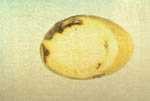
Bacterial ring rot is caused by a rod-shaped, gram-positive bacterium Clavibacter michiganense pv sepedonicum (Corynebacterium sepedonicum). It caused serious crop losses in Canada until the early seventies when intensive seed inspection procedures and disease control programs were adopted. In recent years, these measures have kept disease outbreaks to a minimum. There is a zero tolerance for this disease in seed potatoes. Canada's objective is to eradicate this tuber borne disease.
The bacteria overwinter in slight to moderately infected tubers which may not exhibit symptoms. In Atlantic Canada, the bacteria do not overwinter in field soil but may survive in volunteers. Bacteria can persist for years in dried slime on potato bags, bins, machinery and storage walls and floors. The disease is spread easily by potato cutting knives and equipment used in potato planting, harvesting, handling, storing and transporting.
Ring rot symptoms may first appear 60-70 days after planting but disease expression is dependent on climate and potato cultivar. Under warm growing conditions all of the plant symptoms may be detected while under cooler conditions, few or none of the symptoms may be seen. The first symptoms appear as a pale yellow mottling in the lower leaves which usually show signs of wilting. This may be limited to a single stem at first but affected leaf margins often curl upward, roll inward and eventually, dead brown areas develop. These symptoms usually begin in the lower leaves and proceed upward as the disease progresses. Leaf yellowing may intensify, producing a bar of bright yellow tissue between the veins. With severe infection, the whole plant may wilt and die.


